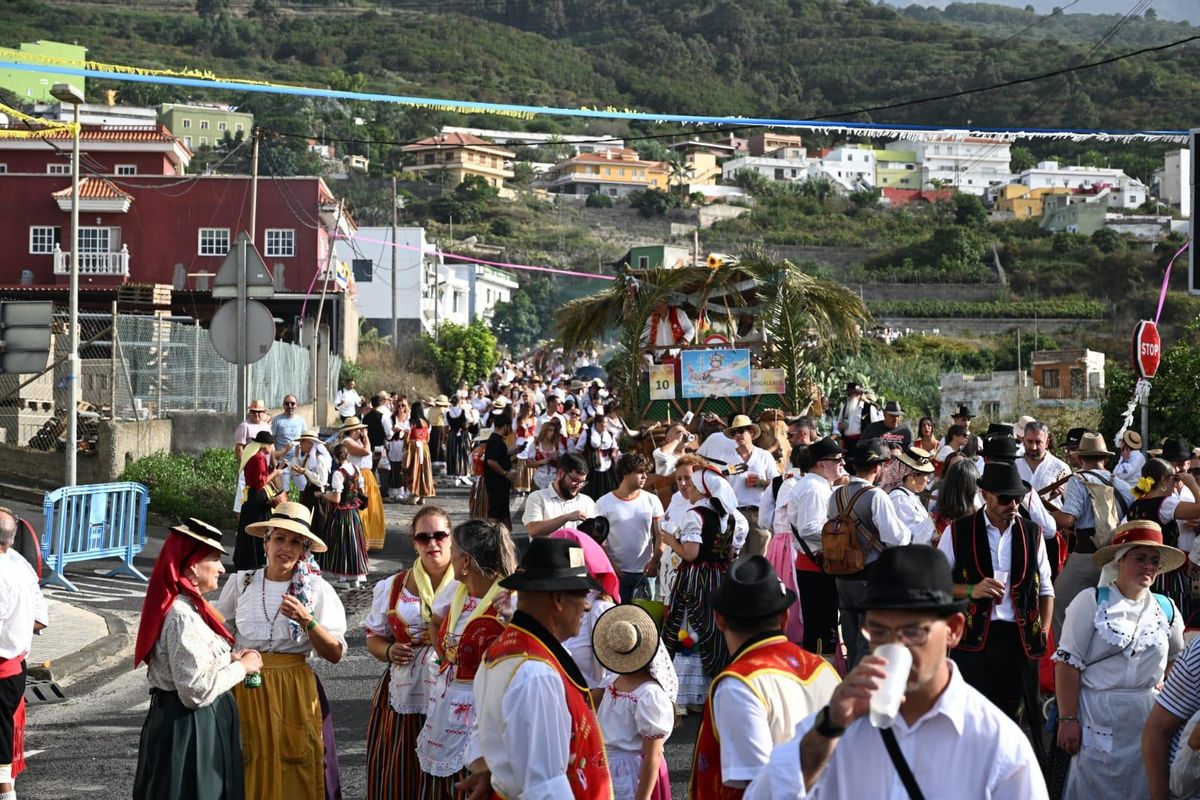A sweltering heat with temperatures reaching 36 degrees at three in the afternoon. At least, that was the reading on the thermometer measuring the outside temperature of one of the microbuses transporting pilgrims free of charge from the vicinity of the San Juan de la Rambla Town Hall square to San Pancracio in Los Canarios, the traditional starting point of the Pilgrimage in honour of San José, also known as La Amable.
There was still an hour to go before the festive procession commenced, and it was clear that the heat would not dampen the festive spirit of this welcoming village, home to around 5,000 residents. Despite the heat felt on the TF-351 road [which leads towards the Domingo Reyes Afonso square], approximately 3,000 people participated in the pilgrimage, according to local police sources. However, it wasn’t just pilgrims on foot; a dozen ox-drawn carts [rented by the Department of Fairs, Festivities, and Pilgrimages] and around fifty small non-motorised carts and decorated she-goats also accompanied the patron saint.
Just before the pilgrimage began, a traditional mass in honour of San José was celebrated. After the religious ceremony, the festivities spilled into the streets. Meat skewers, chistorras, and grilling sausages were being prepared on the smoking barbecues of the carts and then shared among the pilgrims on foot. Hard-boiled eggs, local wine, beer, or water were essential to quench their thirst, all while traditional Canarian folk songs were performed by musical groups.
Folk Music
This music was provided by groups such as Atahona, Parranda Familia Los Alzados, Timcua, Perenkén, Tercera Edad de Icod el Alto, Imoque, La Limera, Tercera Edad Baray, Menceyes de Daute and Ayadirma de Daute. In addition to the songs, a frequent chant of “Viva San José” was met with a resounding collective cheer of “viva.”
The San José Pilgrimage, which celebrates its 30th anniversary this year, is a festival that the residents of Rambla have embraced to such an extent that it feels as though it has been celebrated for over a century.
3,000 people and dozens of carts participate in a festival that marks the end of summer
“This is a day for many of us who were born and raised in San Juan de la Rambla to reconnect,” commented Ruth Abreu, owner of the Flower Culture florist. She has been responsible for embellishing the basin where San José processes for three years. “I have always been very proud to be from San Juan de la Rambla. I’m 35, and this festival is wonderful for gathering with people you may have lost touch with after school, as you go away to study or start working and don’t have much contact. The pilgrimage and the festivities serve to reconnect with people you haven’t seen in a year,” she highlighted. Abreu stated that the pilgrimage is called “La Amable” because people share everything they have, reflecting our character.

Romería de San José en San Juan de la Rambla / El Día
Rubén Díaz rides in the cart named El Grupito and has participated in the pilgrimage almost every year. “We are a group of families, some siblings, others cousins, and some friends who join in.” “We never run out of food and drink here. We’re currently lighting the fire to start putting up the skewers. So if you’d like some, you know where to find us,” Díaz invites.
“It’s a very crowded pilgrimage; the road, which is about six metres wide, is filled from side to side, and the distance between the first and last cart can be two kilometres. The number of participants is impressive, and they call it La Amable because we pilgrims share everything we have. In other places, if you ask for food, you often don’t receive it,” affirms Carlos Rodríguez.













